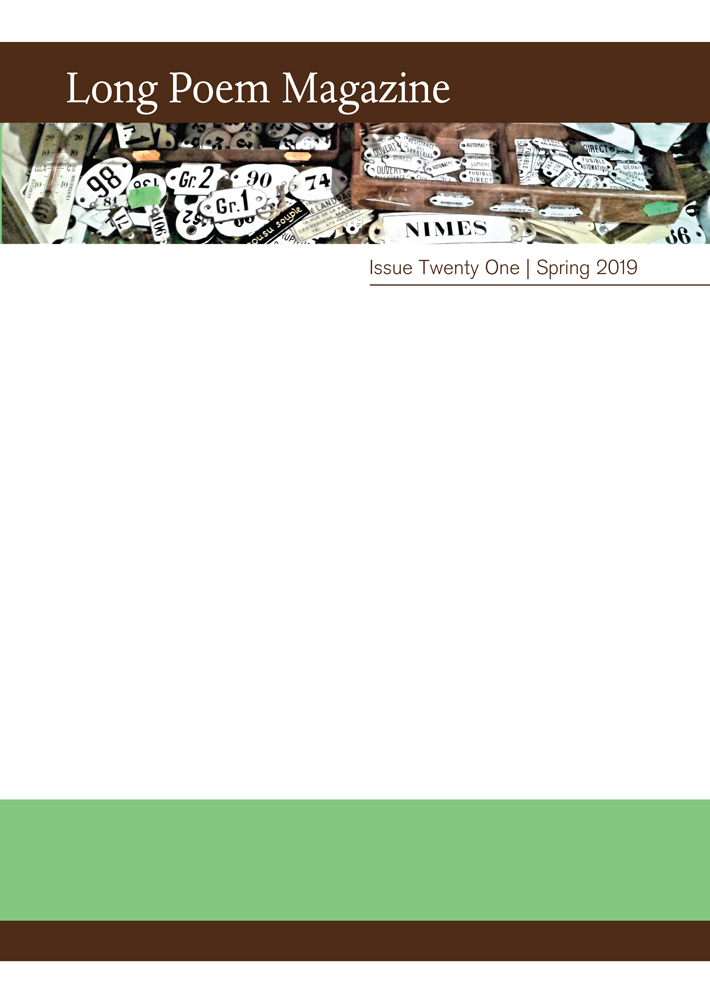Welcome to Issue 21 – nineteen poems, nineteen wide-ranging topics; there’s murder and a miscarriage of justice, an incident at Graham Beach in Auckland, field notes and geology, folklore, climate change, the river Thames, Beijing, baboons (kind of ), the insect world, a red coat spied in Paris, and more. As with previous issues, there are poems that include a combination of research and experience, of stored information and encounters with genres other than poetry. Steve Spence writes sometimes ‘with the radio on in the background so I can include interesting snippets from whatever happens to be in the feed.’ Just as one can write a poem from notes in a journal, as Tom Lowenstein does in ‘Sentences’, so external sources can enrich one’s own language, ideas, sensibilities in a melding of the internal/personal and that which exists (or existed) outside of the self, but impinges in some way – an admixture.
Research can find its way into a poem, or a poem can be research driven, research and poetry intertwined. Take collage, or the cento form in which the appropriation of others’ words is duly acknowledged – or should be. Personally, I am drawn to footnotes and marginalia as an enhancement to the poem. In her book Spontaneous Particulars: The Telepathy of the Archives (New Directions Books 2014), American poet Susan Howe explores the wonder of a library’s literary archive, examining notes, scraps, doodles etc, making discoveries: ‘Each collected object or manuscript is a pre-articulate empty theatre where a thought may surprise itself at the instant of seeing. Where a thought may hear itself see.’ A connection with history can serve to expound the present and help us to validate/gain knowledge of our own place in life. We are amidst. The long poem has room for all of this.
Susan Watson, in ‘Why she began to study the works of Sir Thomas Malory’, ‘… likes the way that it [referring to Morte D’Arthur] reaches a long arm back/towards Chaucer…’, and incorporates parts of the original text into her poem, foregrounding the language of Middle English. On discovering Hilda Carline, Rosie Jackson ‘became obsessed with Hilda’s fragile state of mind after her divorce from [Stanley] Spencer’ (‘In which Hilda brings her complaints to God’). Whilst writing ‘Glossary on a North Sea Landscape’, Alistair Noon became fascinated with ‘German words I had never heard before because the features in question did not exist anywhere else.’ His poem references the St. Marcellus Storm of 1362, the Black Death of 1634 and St. Burchard’s Storm in the Thirty Years’ War. Ditten we learn is ‘sheep shit pie’. An article about finding and mapping arrowheads at Towton battlefield in Wales (1461) led to Richard Morwood’s inventive poem. Iain Britton speaks of a deep connection to the Maori community of Ōhinemutu, where he spent some time, of how ‘their ancient stories and beliefs became interwoven with my European/Celtic side […] how strength of identity is gained through association with people, their history and the land.’ (‘Tongues’)
For her ekphrastic poem about the American folk artist Horace H Pippin, Janice N Harrington studied his paintings, ‘intensely’, researching into both World Wars and the events he portrays, ‘weighing their intersections with African-American history.’ In the exploration of her own deeply personal story in ‘Cuts’, Tamar Yoseloff quotes Yoko Ono preparing ‘to offer her body to strangers’ in her iconic performance of Cut Piece in 1964. Abeer Ameer’s poem, the true story of an Iraqi refugee, is both an emotional response to events in her own family, and a rendering of appalling historical acts of violence against her race. One doesn’t have to be an academic to include or to quote research in a poem – everything doesn’t have to come from the inside of your own head.
Linda Black, May 2019
